Re: Along The Gilpin Tramway - The Wood Mine.
Posted by Keith Pashina on Mar 03, 2025; 4:02am
URL: http://c-sng-discussion-forum.254.s1.nabble.com/Along-The-Gilpin-Tramway-A-Closer-Look-tp20380p20542.html
GUNNELL HILL
Gunnell Hill is a prominent feature on the far west side of Central City. From the town, several mines are seen tiered on all sides of the hill. This was an important mining area, with several active mines shipping on the Gilpin Tram.
As the Gilpin Tram main line leaves Prosser Gulch, it climbs a stiff grade up the north slope of Gunnell Hill, which is named for the prominent Gunnell Mine.
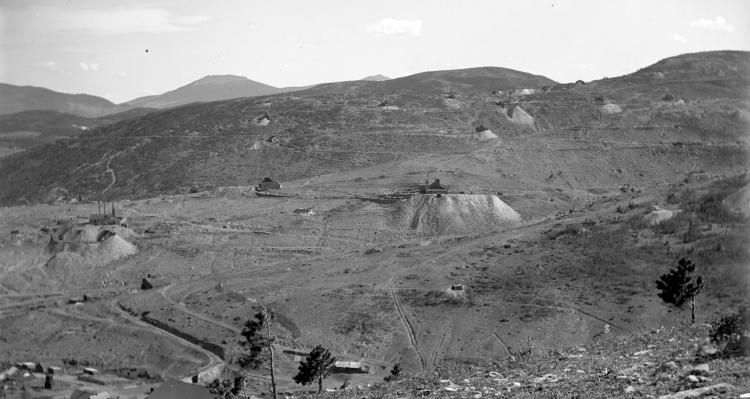
We've seen this photo before, from the Denver Public Library, Western History Collection, Image L-284, titled “View south from Nigger Hill, June, 1899” (renamed Barney Ford Hill in the 1960s), and is looking towards Gunnell Hill. This is where we will be taking a closer look at the Gilpin Tram trackage, mines, and operations.
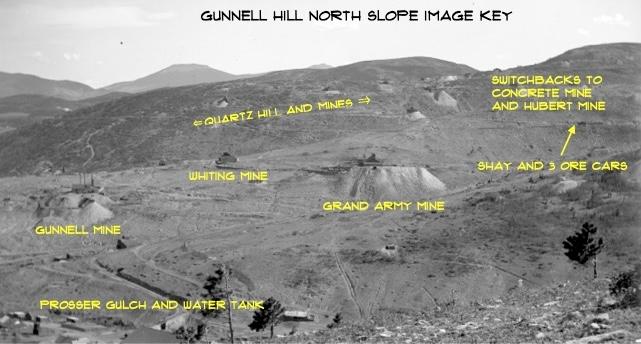
The main features in the previous photo are labeled here. There is a lot of mining activity visible in this photo. H. H. Lake, the photographer, even caught a Gilpin Tram shay and 3 ore cars leaving the Concrete Mine spur.
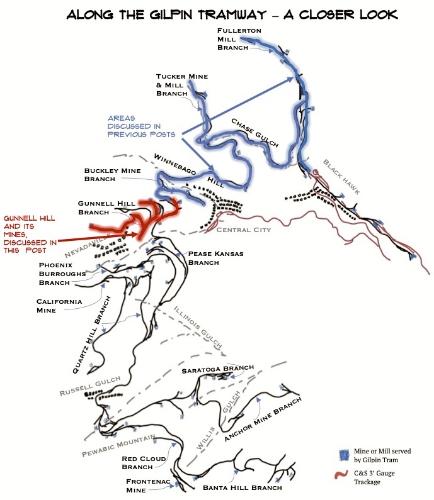
This map shows the areas discussed in previous posts, and the Gunnell Hill area.
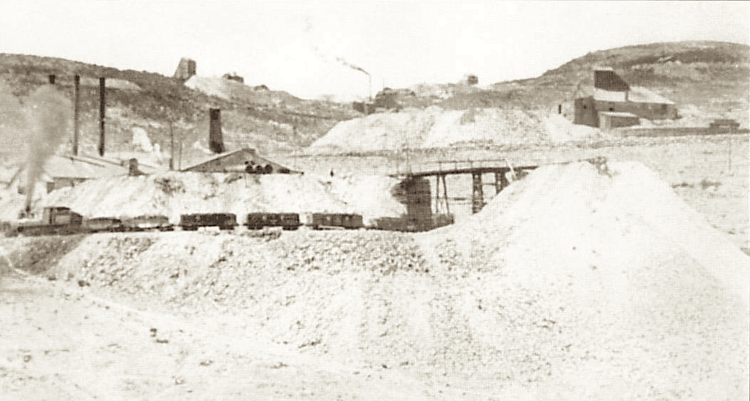
The Gunnell Mine was a big producer in its time. Here a train is heading up the mainline with loads of coal in ore cars and coal cars. The main line curved beneath a trestle on the Gunnell Mine's waste rock dump. Photo courtesy of the Mark Baldwin collection.
Milepost 40.44 - Gunnell Mine Spur No. 1
Using the C&S trackage designations, the Gilpin Tram trackage served the Gunnell Mine with multiple spurs. The mainline wound around the mine itself, passing under the tall ore dump trestle located on the north side of the mine. At this location, which was near the mine waste rock dump track, the Gilpin Tram laid a spur that switch-backed to serve loading operations.
How the Gunnell Mine loaded the ore cars is somewhat of a mystery. The mine spur did not go under the mine building, nor was it parallel to any of the building walls where ore chutes were located. There was an enclosed wood-framed addition on the west side of the building that may have been used for loading ore cars. However, there is this description in the August 31, 1899, Gilpin Observer newspaper, “On Gunnell hill, Mr. Hallihan, the superintendent of construction, has about completed the switchback from the Gilpin Tramway company’s main line to the West Gunnell mines, and put in a switchback for delivering coal at that property. He has also graded off a side switch in order to put empty ore cars down to the east end of the buiding, at which point the ore mined and hoisted can be dumped into ore cars.”
There was a lengthy lawsuit between the owners of the Gunnell Mine and Grand Army Mine. During the suit, there were various shenanigans between the opposing parties, such as stealing ore, throwing sulphur smoke bombs, and other activities. The Gunnell Mine owners finall prevailed in 1894. Soon after, the Weekly Register Call newspaper reported on April 19, 1894, “…A portion of the above sum of money expended was in surface improvements, such as new machinery and the extension of the shaft building over the pump shaft. The tramway company have put in new sidings from their main track which will greatly facilitate the transportation of the ore mined to the sampling works and stamp mills, as well as the transportation of supplies to the mine.” The pump shaft housed a Cornish pump, built locally by the Macfarlane Company. The main shaft was down to 1,088 feet by this time.
The lawsuit settlement facilitated much consolidation of properties on Gunnell Hill as the Gilpin Observer newspaper reported on April 27, 1899, “The Gunnell Company on Gunnell hill have been unable to secure tramway cars to handle the output of stamp mill ore from the workings of the Grand Army shaft on that property, hence their output has been pretty light for the past two months.”
Shortly thereafter, the Gilpin Observer reported on June 22, 1899, “Gunnell Mine Sold – Yesterday, there was placed a deed conveying to the Gunnell Gold Mining and Milling company, all the buidings of the Kimber, Fullerton & Co., on the Gunnell, Whiting, Grand Army, Slaughter House, Marine, Fagan, and Star of Hope, patented mines, on Gunnell hillm this city. Included in the sale are the Polar Star mill (40 stamps), Fullerton lower mill (40 stamps), Fullerton upper mill (33 stamps) all situate on north Clear creek, in Black Hawk…”
Business was good, the Gilpin Observer reported on October 3, 1901, that “The Gunnell Gold Mining and Milling company is now taking out a sufficient amoutn of stamp-mill ore to keep 105 of their 113 stamp capacity employed. All the ore from their holdings is shipped from their mines to their stamp mills on the Gilpin tramway.”
There are traffic records showing ore shipments on the tram in years 1896 to 1904, and 1906. There could be more, it just means there are records existing for those particular periods.
But, just when things were looking good, disaster struck. Newspapers reported that on March 24, 1904, the shaft house burned for the third time and ruined all the machinery. Records seem to be sparse after that point, although there was still apparently some activity in the ensuing years.
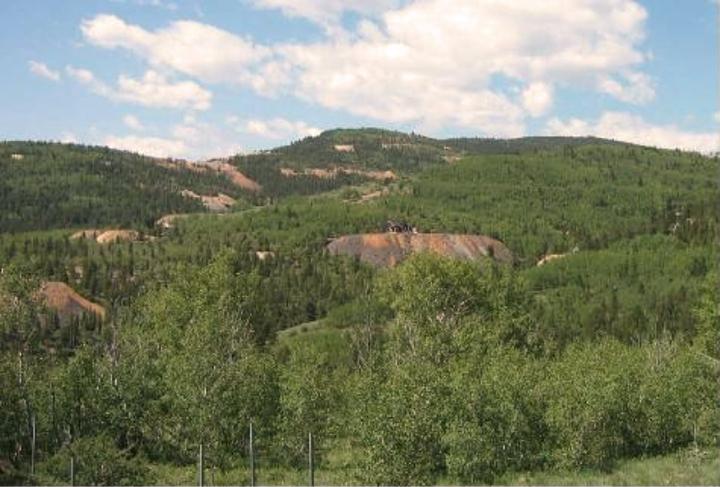
This is a similar view today as in the preceding two photos. Again, the Gunnell dump is at the left margin. The biggest dump seen is the Grand Army dump. Tree growth in the past century conceals many features.
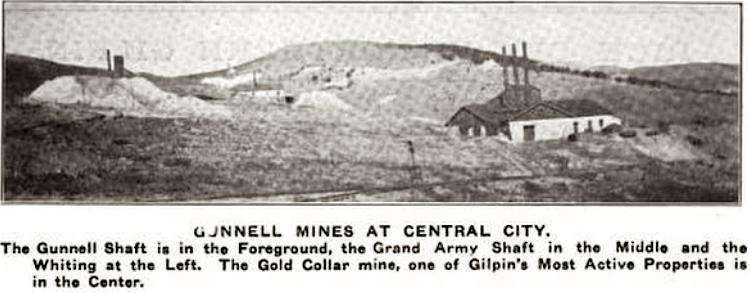
Here is the Gunnell Mine from a January 1917 issue of the Mining Investor magazine. You’ll note that the shape of the mine headframe and enclosure changes over time. The mine itself was modified greatly over the years, mainly because the shaft house burned 3 different times!
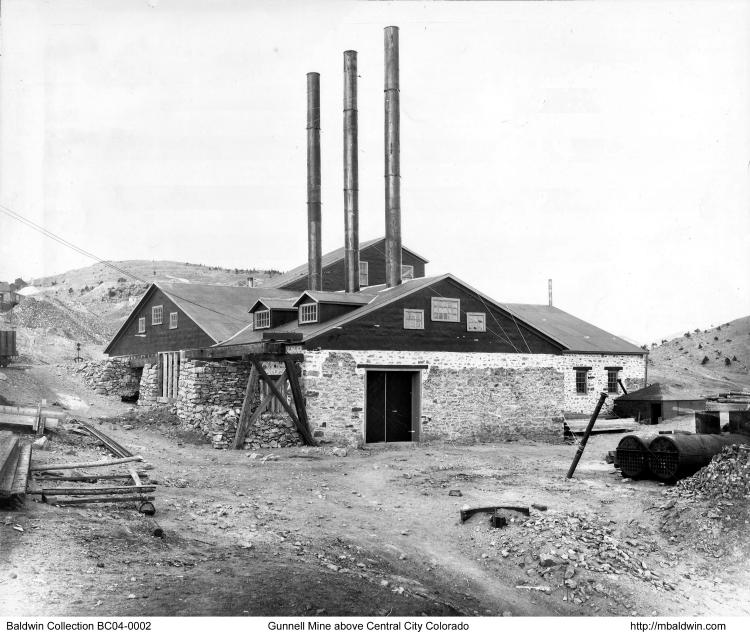
Here is the Gunnell Mine looking prosperous. This image is provided courtesy of the Mark Baldwin collection. There are several items of note in this image. Notice the lower stone wall facing the photographer – this must be the second iteration of the shaft house, after a previous fire. There is new, patched stone masonry visible at the top of the wall. On the left side of the shaft house, the elevated Gilpin Tram trestle, can be seen. This was used for dumping coal at the boilers. At the extreme center left margin, part of a Gilpin Tram coal car can be seen. Notice 2 new boilers sitting in front pf the mine – this photo may have been taken during reconstruction after the previous fire.
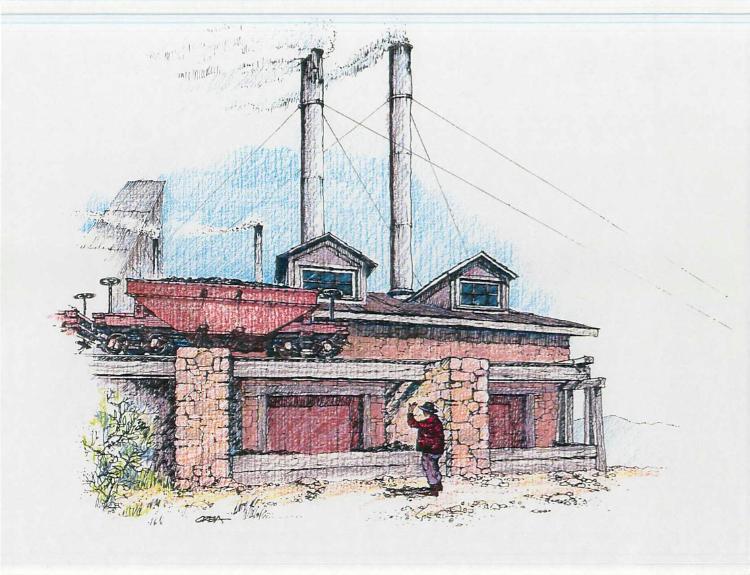
Joe Crea made this sketch showing how the Gilpin Tram’s coal spur to the Gunnell Mine was constructed. The stone piers, stone building wall, and coal pocket doors remain today, as does part of the roof.
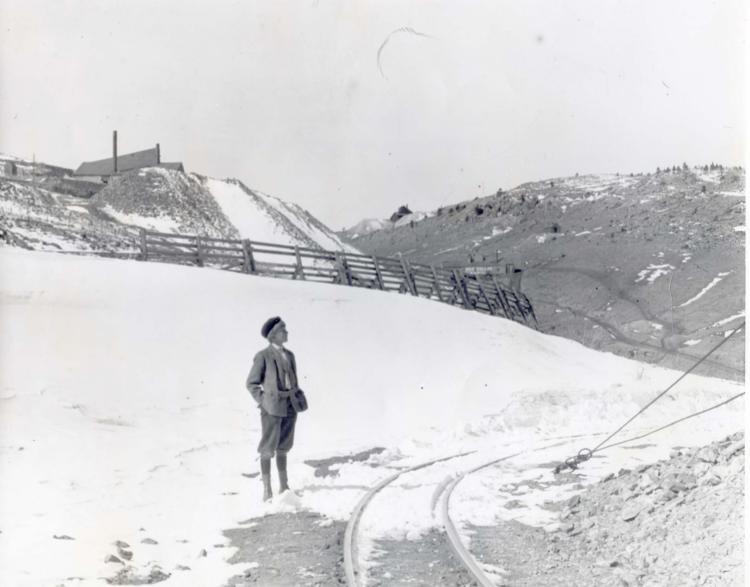
This is an image from the Denver Public Library, Western History collection. The little guy is probably the son of H.H. Lake - he pops up in other photos. He is standing next to the Gilpin Tram spur that curved back around the mine and from where the coal dump spur split off. Two guy wires, likely for the Gunnell Mine smokestacks, can be seen. This is a good image showing how sharp some of the mine trackage spurs were. The Grand Army is the large mine at left background.
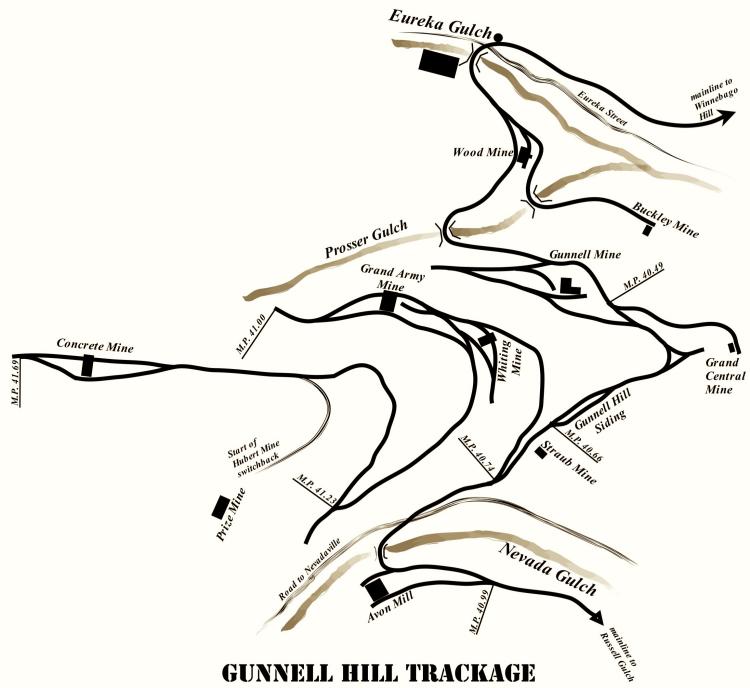
This map shows the trackage on Gunnell Hill, and the major mines.
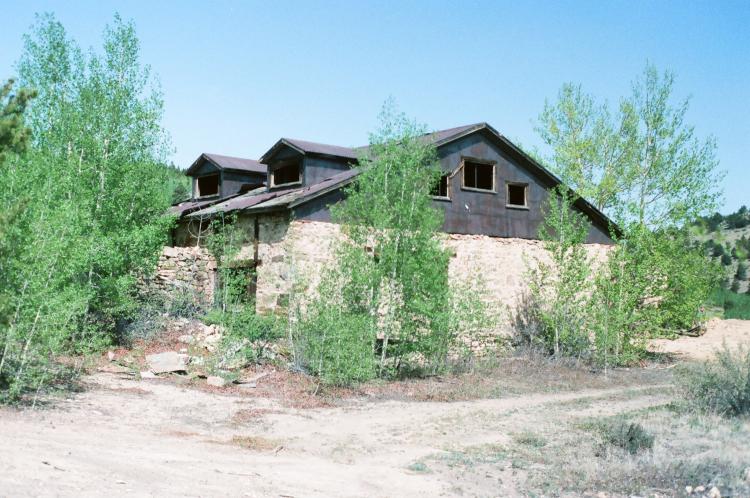
Someone has partially restored the remains of the Gunnell Mine, and the roof and walls of the boiler room end of the building remain. The stone pier for the Gilpin Tram coal spur can be seen on the left side of the building.
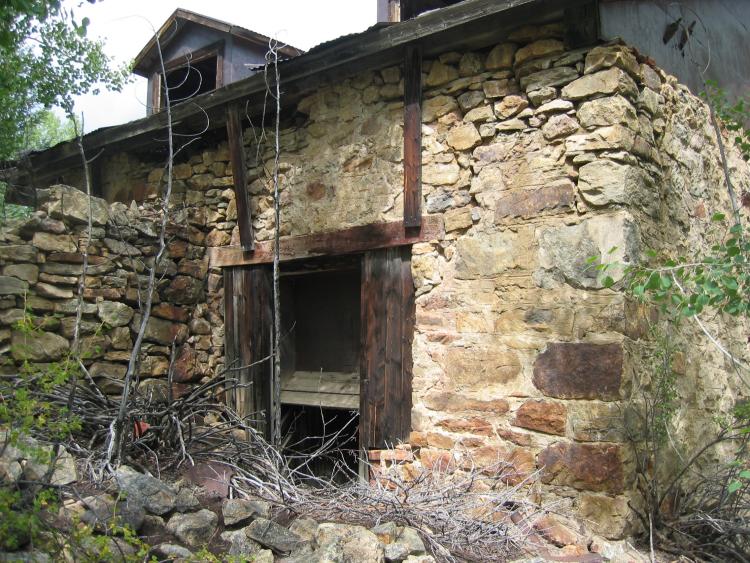
The south wall of the Gunnell Mine shows the two restored wooden coal doors. The stone pier for the Gilpin Tram spur can be seen at left.
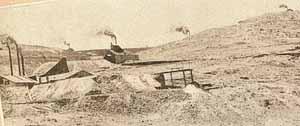
Comparing the above image to one previously posted, we seen the shaft-house of the Gunnell Mine was rebuilt again after a fire. This is an earlier photo from “Glimpses of Golden Gilpin Colorado”, a promotional pamphlet published about 1908 or so. Note that the waste rock at the end of the dump trestle is pretty small at this time. The Whiting Mine is the mine in the background.
URL: http://c-sng-discussion-forum.254.s1.nabble.com/Along-The-Gilpin-Tramway-A-Closer-Look-tp20380p20542.html
GUNNELL HILL
Gunnell Hill is a prominent feature on the far west side of Central City. From the town, several mines are seen tiered on all sides of the hill. This was an important mining area, with several active mines shipping on the Gilpin Tram.
As the Gilpin Tram main line leaves Prosser Gulch, it climbs a stiff grade up the north slope of Gunnell Hill, which is named for the prominent Gunnell Mine.

We've seen this photo before, from the Denver Public Library, Western History Collection, Image L-284, titled “View south from Nigger Hill, June, 1899” (renamed Barney Ford Hill in the 1960s), and is looking towards Gunnell Hill. This is where we will be taking a closer look at the Gilpin Tram trackage, mines, and operations.

The main features in the previous photo are labeled here. There is a lot of mining activity visible in this photo. H. H. Lake, the photographer, even caught a Gilpin Tram shay and 3 ore cars leaving the Concrete Mine spur.

This map shows the areas discussed in previous posts, and the Gunnell Hill area.

The Gunnell Mine was a big producer in its time. Here a train is heading up the mainline with loads of coal in ore cars and coal cars. The main line curved beneath a trestle on the Gunnell Mine's waste rock dump. Photo courtesy of the Mark Baldwin collection.
Milepost 40.44 - Gunnell Mine Spur No. 1
Using the C&S trackage designations, the Gilpin Tram trackage served the Gunnell Mine with multiple spurs. The mainline wound around the mine itself, passing under the tall ore dump trestle located on the north side of the mine. At this location, which was near the mine waste rock dump track, the Gilpin Tram laid a spur that switch-backed to serve loading operations.
How the Gunnell Mine loaded the ore cars is somewhat of a mystery. The mine spur did not go under the mine building, nor was it parallel to any of the building walls where ore chutes were located. There was an enclosed wood-framed addition on the west side of the building that may have been used for loading ore cars. However, there is this description in the August 31, 1899, Gilpin Observer newspaper, “On Gunnell hill, Mr. Hallihan, the superintendent of construction, has about completed the switchback from the Gilpin Tramway company’s main line to the West Gunnell mines, and put in a switchback for delivering coal at that property. He has also graded off a side switch in order to put empty ore cars down to the east end of the buiding, at which point the ore mined and hoisted can be dumped into ore cars.”
There was a lengthy lawsuit between the owners of the Gunnell Mine and Grand Army Mine. During the suit, there were various shenanigans between the opposing parties, such as stealing ore, throwing sulphur smoke bombs, and other activities. The Gunnell Mine owners finall prevailed in 1894. Soon after, the Weekly Register Call newspaper reported on April 19, 1894, “…A portion of the above sum of money expended was in surface improvements, such as new machinery and the extension of the shaft building over the pump shaft. The tramway company have put in new sidings from their main track which will greatly facilitate the transportation of the ore mined to the sampling works and stamp mills, as well as the transportation of supplies to the mine.” The pump shaft housed a Cornish pump, built locally by the Macfarlane Company. The main shaft was down to 1,088 feet by this time.
The lawsuit settlement facilitated much consolidation of properties on Gunnell Hill as the Gilpin Observer newspaper reported on April 27, 1899, “The Gunnell Company on Gunnell hill have been unable to secure tramway cars to handle the output of stamp mill ore from the workings of the Grand Army shaft on that property, hence their output has been pretty light for the past two months.”
Shortly thereafter, the Gilpin Observer reported on June 22, 1899, “Gunnell Mine Sold – Yesterday, there was placed a deed conveying to the Gunnell Gold Mining and Milling company, all the buidings of the Kimber, Fullerton & Co., on the Gunnell, Whiting, Grand Army, Slaughter House, Marine, Fagan, and Star of Hope, patented mines, on Gunnell hillm this city. Included in the sale are the Polar Star mill (40 stamps), Fullerton lower mill (40 stamps), Fullerton upper mill (33 stamps) all situate on north Clear creek, in Black Hawk…”
Business was good, the Gilpin Observer reported on October 3, 1901, that “The Gunnell Gold Mining and Milling company is now taking out a sufficient amoutn of stamp-mill ore to keep 105 of their 113 stamp capacity employed. All the ore from their holdings is shipped from their mines to their stamp mills on the Gilpin tramway.”
There are traffic records showing ore shipments on the tram in years 1896 to 1904, and 1906. There could be more, it just means there are records existing for those particular periods.
But, just when things were looking good, disaster struck. Newspapers reported that on March 24, 1904, the shaft house burned for the third time and ruined all the machinery. Records seem to be sparse after that point, although there was still apparently some activity in the ensuing years.

This is a similar view today as in the preceding two photos. Again, the Gunnell dump is at the left margin. The biggest dump seen is the Grand Army dump. Tree growth in the past century conceals many features.

Here is the Gunnell Mine from a January 1917 issue of the Mining Investor magazine. You’ll note that the shape of the mine headframe and enclosure changes over time. The mine itself was modified greatly over the years, mainly because the shaft house burned 3 different times!

Here is the Gunnell Mine looking prosperous. This image is provided courtesy of the Mark Baldwin collection. There are several items of note in this image. Notice the lower stone wall facing the photographer – this must be the second iteration of the shaft house, after a previous fire. There is new, patched stone masonry visible at the top of the wall. On the left side of the shaft house, the elevated Gilpin Tram trestle, can be seen. This was used for dumping coal at the boilers. At the extreme center left margin, part of a Gilpin Tram coal car can be seen. Notice 2 new boilers sitting in front pf the mine – this photo may have been taken during reconstruction after the previous fire.

Joe Crea made this sketch showing how the Gilpin Tram’s coal spur to the Gunnell Mine was constructed. The stone piers, stone building wall, and coal pocket doors remain today, as does part of the roof.

This is an image from the Denver Public Library, Western History collection. The little guy is probably the son of H.H. Lake - he pops up in other photos. He is standing next to the Gilpin Tram spur that curved back around the mine and from where the coal dump spur split off. Two guy wires, likely for the Gunnell Mine smokestacks, can be seen. This is a good image showing how sharp some of the mine trackage spurs were. The Grand Army is the large mine at left background.

This map shows the trackage on Gunnell Hill, and the major mines.

Someone has partially restored the remains of the Gunnell Mine, and the roof and walls of the boiler room end of the building remain. The stone pier for the Gilpin Tram coal spur can be seen on the left side of the building.

The south wall of the Gunnell Mine shows the two restored wooden coal doors. The stone pier for the Gilpin Tram spur can be seen at left.

Comparing the above image to one previously posted, we seen the shaft-house of the Gunnell Mine was rebuilt again after a fire. This is an earlier photo from “Glimpses of Golden Gilpin Colorado”, a promotional pamphlet published about 1908 or so. Note that the waste rock at the end of the dump trestle is pretty small at this time. The Whiting Mine is the mine in the background.
Keith Pashina
Narrow-minded in Arizona
Narrow-minded in Arizona
| Free forum by Nabble | Edit this page |